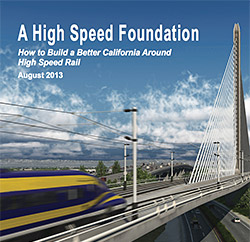
By Andrew Cohen
While high-speed rail in California is fast approaching, a new report suggests that leaders in the San Joaquin Valley may be moving too slowly to ensure economic efficiency and environmental protection.
“High-speed rail is growth-inducing,” said report author Ethan Elkind, a climate policy associate at Berkeley Law’s Center for Law, Energy & the Environment (CLEE) and the UCLA School of Law. “Residents will move to the San Joaquin Valley to have access to it, as will businesses. Cities can either permit that population growth to lead to unchecked development, sprawling over prime farmland and creating more traffic and pollution; or direct it into walkable, thriving neighborhoods connected to high-speed rail via rapid transit.”
The report is the 11th in a series produced by the Climate Change and Business Research Initiative, funded by Bank of America.
The rail project faces legal uncertainty on the heels of an August 16 court ruling that California’s High Speed Rail Authority failed to identify the funds it needs to complete the first phase of construction and receive full environmental clearance. But Sacramento Superior Court Judge Michael Kenny did not issue an injunction to stop construction, which the agency plans to begin in the valley this year. “There’s a new remedy phase starting, but it’s unclear that it will slow down the process,” Elkind said.
Proponents argue that high-speed rail will bring $6 billion in construction investment and countless new jobs, while reducing the need for costly new highway and airport expansions—potentially saving $170 billion over 20 years. If implemented properly with supporting land-use policies, the system could also lower air pollution and help California meet its climate change goals with electric mass transportation.
But Elkind cautions that the system may also have a negative effect on California’s development patterns, hurting the state’s environment, economy, and public health. A rapid expansion of central valley cities would threaten the region’s $43 billion of agricultural resources by clogging already worn roads and freeways and exacerbating air quality problems. To prevent this outcome, the report calls for local leaders to develop a unified plan for economic development and environmental preservation tied to the new rail system.
Stakeholder forum
Berkeley Law and UCLA Law held a lunch event in Fresno August 20 to explain the report’s findings before an audience of local business people and government representatives. Fresno Mayor Ashley Swearengin, a high-speed rail supporter, gave the keynote address. Elkind moderated a panel with High Speed Rail Authority board member Tom Richards, farmer and agricultural representative Holly King, and developer Jeff Roberts.
“Mayor Swearingen spoke of the Authority’s positive, growth-inducing role and implored cities along the route to work with it to improve the siting of stations,” Elkind said. “She endorsed a number of the report’s recommendations, including tax-increment financing for redevelopment around station areas and retooled enterprise zones around rail stations.”
The report cites ways valley leaders can overcome barriers to efficient development of a high-speed rail system. These include:
- creating a valley-wide organizing effort to optimize high-speed rail decision making;
- allocating local government resources for planning and outreach;
- limiting developments that require residents to drive to services and jobs; and
- financing station-related projects to help improve center-city neighborhoods and older urban corridors.
“We need smart local planning for better neighborhoods that is coordinated across the region’s cities,” Elkind said. “Without good planning, the development patterns will be haphazard and inefficient, and they won’t capitalize on growing trends for walkable, connected neighborhoods.”
The report offers additional steps that government leaders, businesses, and the public can take to maximize the rail system’s benefits, while protecting the environment. They include enlisting a valley-wide agency to develop a vision for regional economic growth and environmental preservation linked to high-speed rail; supporting planning efforts and outreach to implement the vision; illustrating the costs of developments that fail to support that vision; and sparking private investment in pedestrian, bike, and transit-accessible projects connected to rail stations.
“There’s some positive movement to create a regional vision for high-speed rail,” Elkind said. “We’ve seen ongoing efforts by local cities to strategize better, as well as by regional entities to plan where transportation dollars should go. But more work needs to be done.”